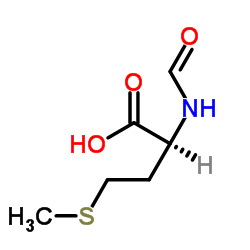Formyl-L-methionine

Formyl-L-methionine structure
|
Common Name | Formyl-L-methionine | ||
|---|---|---|---|---|
| CAS Number | 4289-98-9 | Molecular Weight | 177.221 | |
| Density | 1.2±0.1 g/cm3 | Boiling Point | 453.5±40.0 °C at 760 mmHg | |
| Molecular Formula | C6H11NO3S | Melting Point | 101 ℃ | |
| MSDS | Chinese USA | Flash Point | 228.1±27.3 °C | |
|
A novel amino acid analysis method using derivatization of multiple functional groups followed by liquid chromatography/tandem mass spectrometry.
Analyst 140(6) , 1965-73, (2015) We have developed a novel amino acid analysis method using derivatization of multiple functional groups (amino, carboxyl, and phenolic hydroxyl groups). The amino, carboxyl, and phenolic hydroxyl groups of the amino acids were derivatized with 1-bromobutane s... |
|
|
Functional roles of TAP and tapasin in the assembly of M3-N-formylated peptide complexes.
J. Immunol. 167(3) , 1507-14, (2001) H2-M3 is a MHC class Ib molecule with a high propensity to bind N-formylated peptides. Due to the paucity of endogenous Ag, the majority of M3 is retained in the endoplasmic reticulum (ER). Upon addition of exogenous N-formylated peptides, M3 trafficks rapidl... |
|
|
Immunization with f-Met peptides induces immune reactivity against Mycobacterium tuberculosis
Tuber. Lung Dis. 80(1) , 5-13, (2000) Objective: To determine whether synthetic peptides containing an amino terminal formyl-methionine residue and corresponding to the sequence of several proteins produced by Mycobacterium tuberculosis, would elicit an immune response in mice. Design: Peptides c... |
|
|
Immunization with gp96 from Listeria monocytogenes-infected mice is due to N-formylated listerial peptides.
J. Immunol. 167(11) , 6480-6, (2001) N-Formylated (N-f-met) peptides derived from proteins of the intracellular bacterium Listeria monocytogenes generate a protective, H2-M3-restricted CD8 T cell response in C57BL/6 mice. N-f-met peptide-specific CTL were generated in vitro when mice previously ... |
|
|
Variable immunodominance hierarchies for H2-M3-restricted N-formyl peptides following bacterial infection.
J. Immunol. 166(2) , 1132-40, (2001) H2-M3-restricted presentation of N-formyl methionine (f-Met) peptides to CD8(+) T cells provides a mechanism for selective recognition of bacterial infection. In this report we demonstrate that Listeria monocytogenes infection induces distinct CD8(+) T cell p... |
|
|
Glucose 6-phosphate release of wild-type and mutant human brain hexokinases from mitochondria.
J. Biol. Chem. 280(46) , 38403-9, (2005) One molecule of glucose 6-phosphate inhibits brain hexokinase (HKI) with high affinity by binding to either one of two sites located in distinct halves of the enzyme. In addition to potent inhibition, glucose 6-phosphate releases HKI from the outer leaflet of... |
|
|
T cell response to N-formylated peptides in humans.
Eur. J. Immunol. 31(9) , 2762-70, (2001) We present the first evidence of a T lymphocyte response to N-formylated peptides in humans. N-formylated peptide sequences from self (mitochondrial) and foreign (microbial) antigens were used to isolate antigen-specific T cell clones from healthy individuals... |
|
|
Role of N-terminal protein formylation in central metabolic processes in Staphylococcus aureus.
BMC Microbiol. 13 , 7, (2013) Bacterial protein biosynthesis usually depends on a formylated methionyl start tRNA but Staphylococcus aureus is viable in the absence of Fmt, the tRNAMet formyl transferase. fmt mutants exhibit reduced growth rates indicating that the function of certain pro... |
|
|
A transporter of Escherichia coli specific for L- and D-methionine is the prototype for a new family within the ABC superfamily.
Arch. Microbiol. 180(2) , 88-100, (2003) An ABC-type transporter in Escherichia coli that transports both L- and D-methionine, but not other natural amino acids, was identified. This system is the first functionally characterized member of a novel family of bacterial permeases within the ABC superfa... |
|
|
Cross-recognition of N-formylmethionine peptides is a general characteristic of H2-M3-restricted CD8+ T cells.
Infect. Immun. 73(7) , 4423-6, (2005) H2-M3-restricted CD8+ T cells can exhibit cross-reactivity to different bacterially derived N-formylmethionine peptides. The extent of this promiscuity is unclear. We deleted the nonredundant fMIVTLF epitope and found that Listeria monocytogenes still primed ... |